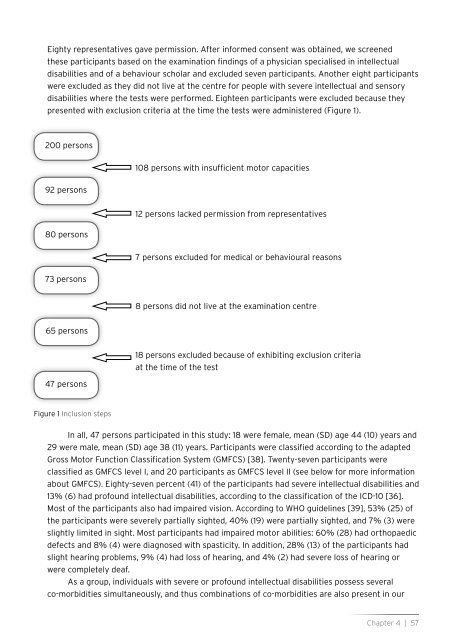Measuring physical fitness in Persons with Severe/Profound ...
Measuring physical fitness in Persons with Severe/Profound ...
Measuring physical fitness in Persons with Severe/Profound ...
- No tags were found...
You also want an ePaper? Increase the reach of your titles
YUMPU automatically turns print PDFs into web optimized ePapers that Google loves.
Eighty representatives gave permission. After <strong>in</strong>formed consent was obta<strong>in</strong>ed, we screenedthese participants based on the exam<strong>in</strong>ation f<strong>in</strong>d<strong>in</strong>gs of a physician specialised <strong>in</strong> <strong>in</strong>tellectualdisabilities and of a behaviour scholar and excluded seven participants. Another eight participantswere excluded as they did not live at the centre for people <strong>with</strong> severe <strong>in</strong>tellectual and sensorydisabilities where the tests were performed. Eighteen participants were excluded because theypresented <strong>with</strong> exclusion criteria at the time the tests were adm<strong>in</strong>istered (Figure 1).200 persons92 persons108 persons <strong>with</strong> <strong>in</strong>sufficient motor capacities12 persons lacked permission from representatives80 persons7 persons excluded for medical or behavioural reasons73 persons8 persons did not live at the exam<strong>in</strong>ation centre65 persons47 persons18 persons excluded because of exhibit<strong>in</strong>g exclusion criteriaat the time of the testFigure 1 Inclusion stepsIn all, 47 persons participated <strong>in</strong> this study: 18 were female, mean (SD) age 44 (10) years and29 were male, mean (SD) age 38 (11) years. Participants were classified accord<strong>in</strong>g to the adaptedGross Motor Function Classification System (GMFCS) [38]. Twenty-seven participants wereclassified as GMFCS level I, and 20 participants as GMFCS level II (see below for more <strong>in</strong>formationabout GMFCS). Eighty-seven percent (41) of the participants had severe <strong>in</strong>tellectual disabilities and13% (6) had profound <strong>in</strong>tellectual disabilities, accord<strong>in</strong>g to the classification of the ICD-10 [36].Most of the participants also had impaired vision. Accord<strong>in</strong>g to WHO guidel<strong>in</strong>es [39], 53% (25) ofthe participants were severely partially sighted, 40% (19) were partially sighted, and 7% (3) wereslightly limited <strong>in</strong> sight. Most participants had impaired motor abilities: 60% (28) had orthopaedicdefects and 8% (4) were diagnosed <strong>with</strong> spasticity. In addition, 28% (13) of the participants hadslight hear<strong>in</strong>g problems, 9% (4) had loss of hear<strong>in</strong>g, and 4% (2) had severe loss of hear<strong>in</strong>g orwere completely deaf.As a group, <strong>in</strong>dividuals <strong>with</strong> severe or profound <strong>in</strong>tellectual disabilities possess severalco-morbidities simultaneously, and thus comb<strong>in</strong>ations of co-morbidities are also present <strong>in</strong> ourChapter 4 | 57











